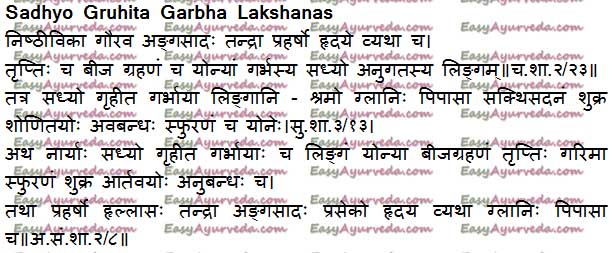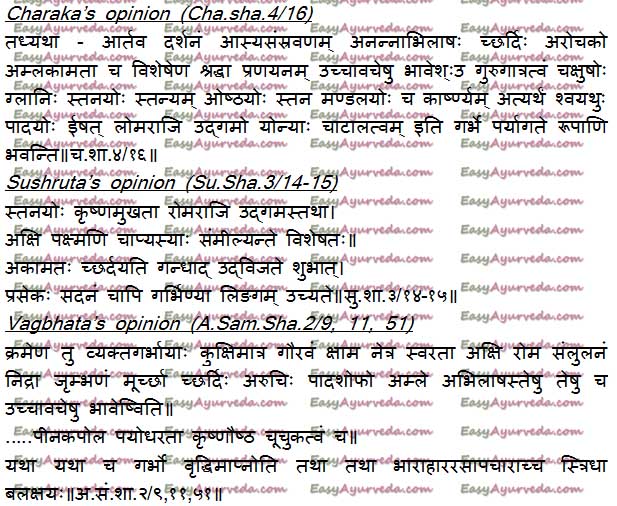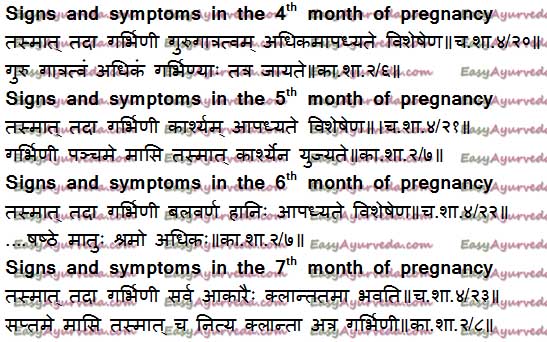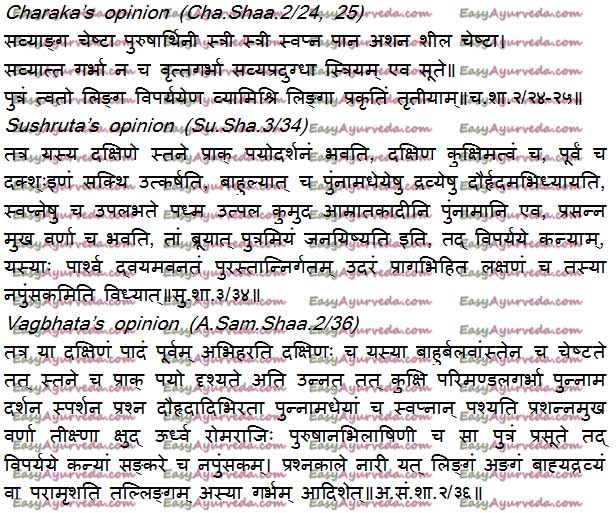Signs And Symptoms Of Pregnancy – Ayurvedic Perspective
By Dr Raghuram Y. S. MD (Ay) & Dr Manasa B. A. M. S
Ayurveda has described in detail about signs and symptoms of pregnancy. Ancient Ayurvedic seers have keenly observed changes occurring in pregnancy and have documented them.
Table of Contents
Signs of recent pregnancy
Sadyo Gruheeta Garbha Lakshana:
Immediately after conception some signs and symptoms are seen in pregnant woman. These are called as sadhyo gruhita garbha lakshanas. Read – Conception And Formation Of Fetus As Per Ayurveda
Sadhyo = immediately Gruhita = conceived (in this context) Garbha = fetus Lakshana = signs and symptoms
These signs and symptoms indicate that conception has taken place, just now.
- Repeated spitting
- Heaviness of body
- Malaise
- Drowsiness
- Goosebumps
- Discomfort in heart region
- Contentment
- Withholding of sperms in vagina
- Fatigue
- Languor
- Excessive thirst
- Lassitude in thighs
- Quivering in entire body and vagina
- Retention of menstrual blood and semen in vagina
- Nausea
- Excessive salivation
Sanskrit verse

Charaka, Sushruta’s view
Charaka’s view (Cha. shaa. 2/23)
- Nishteevana – repeated spitting
- Gourava – heaviness of body
- Angasada – malaise
- Tandra – drowsiness,
- Praharsha – goosebumps
- Hrudaya vyatha – pain or discomfort in cardiac region
- Tripti – feel of comfort or content
- Beeja grahanam – withholding of seed or sperm in yoni (sperm needed for conception, fertilization)
Sushruta’s view (Su. shaa. 3/13)
- Shrama – fatigue
- Glani – languor
- Pipasa – excessive thirst
- Sakthi sadanam – lassitude in thighs
- Shukra shonita avabandha – retention of shukra and shonita in yoni i. e. retention of menstrual and coital discharges in vagina or absence of same (depicts conception)
- Yoni sphurana – quivering in vagina
Read – Herbs Useful For Maintenance Of Pregnancy
Vagbhata’s view (As. Sam. Shaa. 2/8)
- Beeja grahana in yoni – retention of sperms in female genital tract, depicts fertilization and subsequent conception
- Trupti – feel of content or comfort
- Sphurana –quivering
- Shukra artva anubandha – union of sperm and ovum
- Praharsha – goosebumps
- Hrullasa – nausea, feel to vomit
- Tandra – sleepiness / drowsiness
- Angasaada – malaise
- Praseka – excessive salivation
- Hrudaya vyatha – pain or discomfort in heart region
- Glani – languor
- Pipasa – thirst
Vagbhata 2 (A. Hru. Shaa. 1/37, 38)
- Beeja sangraha in yoni – Retention of semen or sperms in female genital tract
- Trupti – feel of comfort
- Gurutva – feeling of heaviness
- Sphurana – quivering
- Shukra asra anubandha – union of sperm and ovum marking onset of conception
- Hrudaya spandana – increased heart beats
- Tandra – drowsiness, sleepiness
- Trut – excessive thirst
- Glani – languor
- Lomaharshana – horripulation, goosebumps
Read – Ayurvedic Treatment For Stretch Marks During Pregnancy
Manifested pregnancy symptoms
Vyakta Garbha Lakshana Vyakta = manifested
When embryo gets implanted in uterus and gets manifested certain signs and symptoms of pregnancy are manifested. These are called vyakta garbha lakshanas. They are also called gruhita garbha lakshanas and garbhini linga. Read – Morning Sickness: Ayurvedic Treatment, Home Remedies
Below mentioned are signs and symptoms of pregnancy wherein body parts of embryo have been conspicuous. These according to Ayurveda are signs of late pregnancy which are manifested after 3 months of pregnancy.
- Amenorrhea
- Excessive salivation
- Aversion towards food and anorexia
- Nausea
- Vomiting
- Craving for sour foods
- Desires for high and low quality foods alternatively
- Heaviness of body parts and abdomen
- Languor in eyes
- Secretion of breast milk
- Blackish discoloration of lips and areola and nipples
- Edema of feet
- Development of linea nigra
- Dilatation of vagina
- Coalescing of eyelashes
- Getting irritated from good smell
- Tiredness
- Weakness of eyes and voice
- Sleepiness
- Yawning
- Unconsciousness
- Corpulence of cheeks and breasts
- Decrease in strength
- Emaciation
- Burning sensation in whole body
- Various kinds of desires
Read – After Delivery Care Of Mother For First Three Months By Ayurveda
Charaka has said that description of signs and symptoms of pregnancy for recognition, identification and management of ‘Douhruda stage’. Douhruda means ‘woman having two hearts’ i. e. one heart of her own and other heart of embryo developing in her, which means pregnant.
Chakrapani, commentator of Charaka opines that this stage starts from 3rd month.
Dalhana, commentator of Sushruta tells that term ‘garbhini linga’ written by Sushruta reflects ‘uttarakalina gruhita garbha lakshana’ i. e. signs and symptoms of late pregnancy, i. e. signs and symptoms of pregnancy which are seen after ‘signs of immediate conception’ i. e. ‘sadhyo gruhita garbha lakshanas’.
Thus, according to Dalhana –
- Sadhyo Gruhita Garbha Lakshanas – means signs and symptoms of immediate conception
- Vyakta Garbha Lakshanas or Gruhita Garbha Lakshanas (according to Sushruta) –
- means signs and symptoms of pregnancy which are seen after sadhyo gruhita garbha lakshanas i. e. they are signs and symptoms of late pregnancy (seen at 3 months and later according to Chakrapani, beginning of douhruda)
Vagbhata has clearly mentioned these symptoms as ‘Vyakta Garbha Lakshanas’ i. e. signs and symptoms of clearly manifested fetus. Indu, commentator of Ashtanga Sangraha says that ‘Vyakta Garbha lingas mean signs and symptoms of a pregnant woman who possesses embryo of conspicuous but under-developed body parts’. Read – Essential Elements For Conception – Garbha Sambhava Samagri
Thus, Vyakta Garbha Lakshanas according to different authors sums up to following meanings –
- Signs and symptoms of pregnancy
- Signs and symptoms of late pregnancy which manifest after manifestation of immediate signs of conception
- Signs and symptoms of pregnant woman
- Signs and symptoms of pregnancy which indicate douhruda stage i. e. manifestation of second heart in pregnant woman, which happens to be after 3 months of pregnancy (Chakrapani)
- Signs and symptoms of a pregnant woman possessing embryo of conspicuous but under-developed body parts
- Signs and symptoms indicating clear establishment of fetus
Sanskrit verse-2

Charaka’s opinion (Cha. sha. 4/16)
- Artava adarshana – amenorrhea
- Asya samsrava – excessive salivation
- Anannabhilasha – aversion towards food
- Chardi – vomiting
- Arochaka – anorexia
- Amla kamata – craving for sour foods
- Shraddhaa pranayanam uccha vacheshu bhaveshu – alternate desires for high quality and low quality foods, articles and lifestyle practices / deeds
- Gurugatratvam – heaviness of body parts
- Chakshu glani – languor in both eyes
- Stanayoh stanyam – secretion of breast milk from breasts
- Stana oshtayoh stana mandalayoh kaarshnyam atyartham – blackish discoloration of lips and areola of breasts
- Paadayoh ishat shwayathu – slight edema of feet
- Roma raji udgamah – development of linea nigra
- Yonyah chatalatvam – dilatation of vagina
Sushruta’s opinion (Su. Sha. 3/14-15)
- Stanayoh krushna mukhata – blackening of areola
- Roma raji udgama – manifestation of linea nigra
- Akshi pakshmani samilyate – eyelashes coalesce
- Akamata chardi – vomiting without apparent cause
- Shubhaat gandhaat udvijate – gets irritated from good smells
- Prasekah – excessive salivation
- Sadanam – tiredness
Read – Anomalies, Defects In Fetus, Ayurvedic Treatment
Vagbhata’s opinion (A. Sam. Sha. 2/9, 11, 51)
- Kukshi matra gauravam – heaviness of abdomen
- Kshaama netra swarataa – weakness of eyes and voice
- Akshi roma samlulana – disordered eye lashes or quivering of eye lashes (pubic hairs – Indu)
- Nidra – sleepiness
- Jrumbhanam – yawning
- Moorcha – unconsciousness, fainting
- Chardhi – vomiting
- Aruchi – anorexia
- Pada shopho – edema of legs / feet
- Amla abhilasha – craving for sour substances / food
- Teshu cha uchcha vacheshu bhaveshu – desires for high quality and low quality foods
- Peena kapola payodharata – cheeks and breasts become corpulent
- Krishna oshta chuchukatvam – blackish discoloration of lips and nipples
- Bala kshaya – as fetus grows in womb, its weight increases and there is diversion of her nutrients towards child, consequentially her energy decreases
Vagbhata’s opinion (A. Hr. Shaa. 1/50-52)
- Kshaamata – emaciation
- Kukshi Garimaa – heaviness in abdominal area
- Murcha – fainting
- Chardi – vomiting
- Arochaka – anorexia
- Jrumbha – yawning
- Praseka – excessive salivation
- Sadanam – languor
- Romarajyaha prakashanam – appearance of linea nigra
- Amla ishtata – liking towards sour foods and substances
- Peenau stanau – corpulence of breasts
- Sa stana krushna chuchukau – blackish discoloration of areola and nipples
- Pada shopha – swelling of feet
- Vidaha – burning sensation in whole body
- Anye sraddhah cha vividhatmikaa – expression of various desires
Read –Monthly Development Of Fetus – Ayurvedic perspective
Masanumasika Lakshanas
Garbhini = pregnant woman Masanumasika = every month
As fetus grows in womb different signs and symptoms are seen and documented in every month of pregnancy. These are called masanumasika lakshanas.
- In fourth month of pregnancy heaviness of body is manifested.
- In fifth month of pregnancy pregnant woman becomes emaciated.
- In sixth month of pregnancy woman undergoes loss of strength and complexion.
- In seventh month of pregnancy woman experiences extreme exhaustion.

Signs and symptoms in 4th month of pregnancy
Gurugatratvam – Guru gatratvam means heaviness of body. In fourth month of pregnancy fetus gets stabilized. Due to this, weight of fetus increases comparably. As a result, pregnant woman feels more heaviness in body.
Signs and symptoms in 5th month of pregnancy
Karshya – Karshya means emaciation. In fifth month of pregnancy, muscles and blood of fetus gets nourished and enriched.
Chakrapani, commentator of Charaka Samhita, gives a clarification for emaciation in pregnant woman in 5th month of pregnancy. He says, since this nutrition reaches to fetus from mother, i. e. from mother’s rasa dhatu or nutrition, there will be insufficient rasa to nourish tissues of mother (pregnant woman). Since tissues are not properly nourished and enriched as a result of diversion of maximum part of nutrition towards fetus, pregnant woman loses little weight and gets emaciated.
In actual terms, if diet and health of pregnant woman is normal, she gains considerable weight from 4th to 7th month. Hence there will be no emaciation.
Signs and symptoms in 6th month of pregnancy
Bala-varna hani, shramadhikya – Bala varna hani means loss of strength and complexion. Shramadhikya means more tiredness. In 6th month of pregnancy, pregnant woman suffers from loss of strength and complexion. She feels more tired. This is because during 6th month there is enhancement of strength and complexion in fetus, which is derived in excess from mother’s nutrition. Thus there is a compensatory loss of strength and complexion in mother.
Face-mask or deposition of pigments in other parts of body might have been referred as loss of complexion. Read – Varnya Gana: Complexion Enhancing Herbs: Review, Uses, Formulations
Signs and symptoms in 7th month of pregnancy
Sarva aakaraih klantatama – Sarva aakaraih klantatama means excessive exhaustion by all means. In 7th month of pregnancy, pregnant woman feels excessively exhausted. She also has relatively more loss of flesh and blood during this month. This happens since fetus attains over all maturity in this month. Excessive exhaustion of pregnant woman is due to her contribution to overall maturity of fetus in terms of losing her flesh and blood.
Read – 15 Precautions And Benefits Of Massage In Pregnancy
Yugma Garbha – Signs in twin pregnancy
When the abdomen of pregnant woman is elevated on both sides and depressed in centre just like a trough i. e. droni bhutam udaram, will deliver twins. (Su. Sha. 3/34 & A. Hr. Shaa. 1/72)

Dauhruda Lakshana
Dauhruda means two hearts. Pregnant woman in 3rd and 4th (according to some other authors) months of pregnancy is called dauhridini i. e. ‘ one with two hearts’ because she will have a heart of hers and other heart of fetus.
Fetal heart is connected to maternal heart through rasavahi srotas. Child communicates its desire through these channels. Pregnant woman expresses certain desires during this period which are actually desires of fetus. These desires of fetus expressed through expectant mother are called dauhruda. Read – Pregnancy Cravings – Reasons, Ayurvedic Explanation
All ancient authors opine that desires of pregnant woman i. e. dauhruda should not be suppressed in fact they should be fulfilled. If desires are not fulfilled vata gets aggravated reaches fetus and destroys fetus or cause several complications. child may be born with many mind and body anomalies. If desires of dauhrudini are satisfied and granted child born will be intelligent healthy and virtuous.
Click to Consult Dr Raghuram Y. S. MD (Ayu) – Email / Skype









